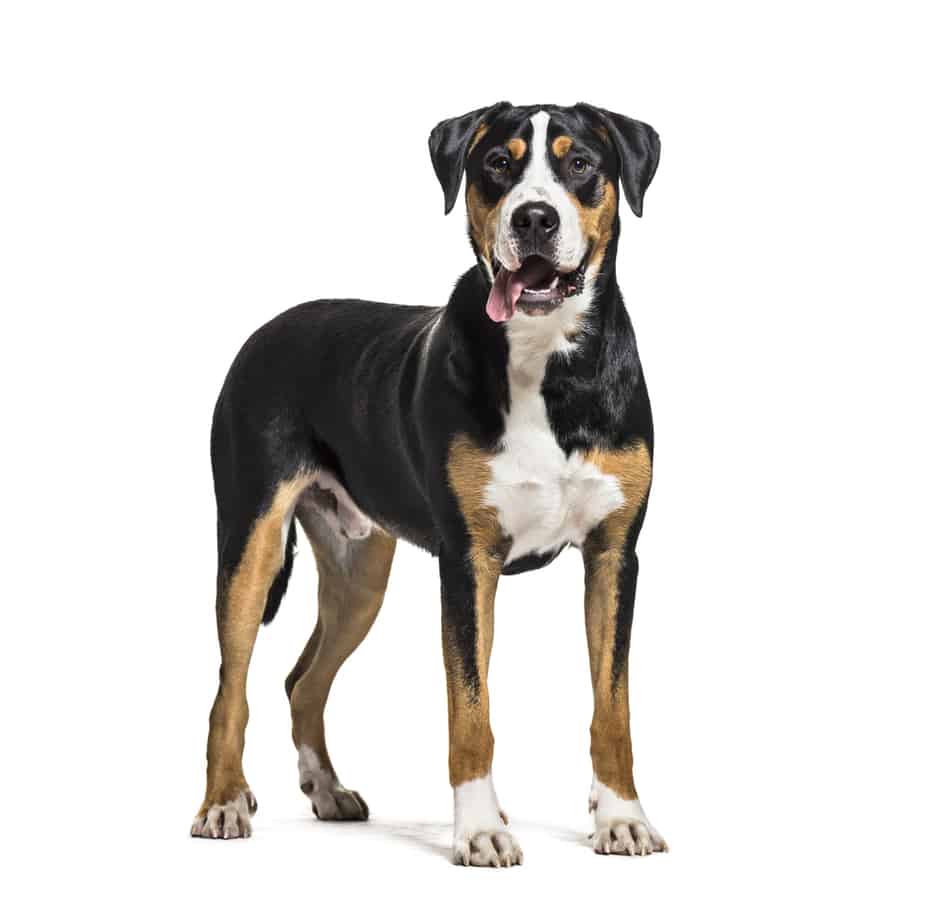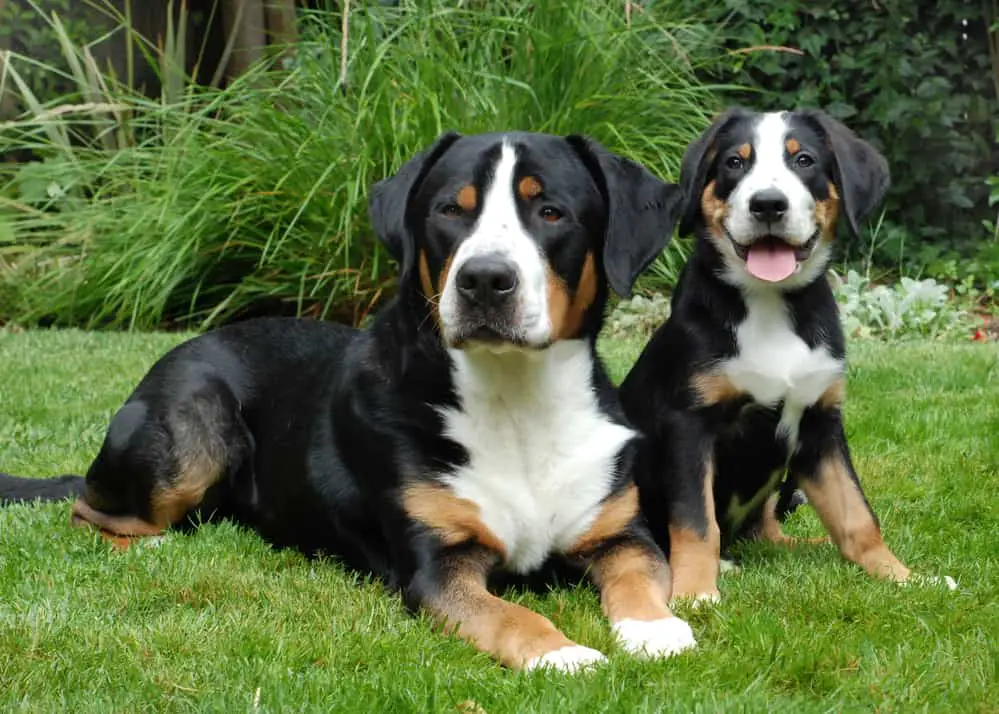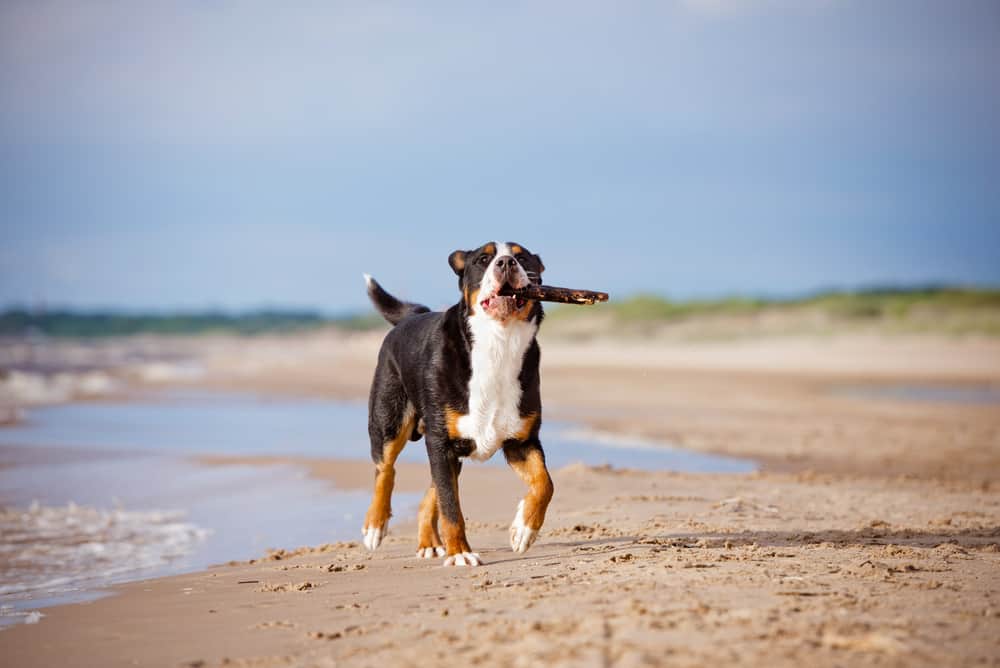Complete Guide To The Greater Swiss Mountain Dog: Health, Grooming, Feeding and More
Greater Swiss Mountain Dogs reflect the beauty of the region where they were bred. As majestic and rugged as the Alps, they’re hardworking helpers and devoted family friends.
I have a few clients in my veterinary practice that are devoted fans of this breed and have been bringing me Greater Swiss Mountain dogs for years. They’re smart, relatively calm compared to many other dogs their size, and are low-maintenance.
Table of Contents
How Big Do Greater Swiss Mountain Dogs Get?
| Height | Weight | |
| Male | 25.5″ – 28.5″ at the shoulder | 115-140 lbs |
| Female | 23.5″ – 27″ at the shoulder | 85-110 lbs |

What Do Greater Swiss Mountain Dogs Look Like?
Bred to pull carts and move cattle, the Greater Swiss Mountain dog is a breed of incredible strength. They’re muscular and powerful without being lean. Heavy-boned, they’re thickset and sturdy.
The stunning tri-color coat of a Greater Swiss shines in shades of black, white and rust — other colors are a disqualification. The undercoat ranges from gray to tawny and should be at least minimally visible.
Deep brown eyes and blunt muzzle give them a sweet, curious expression. Their wide ears fold over toward the front, framing their broad head. Tails are long and tapered.
The oldest of many dogs developed in the Swiss Alps from the same ancestors, the Greater Swiss Mountain Dogs are similar in size, color and conformation to the Bernese Mountain Dog, Appenzeller Sennenhund, Entlebucher Mountain Dog and to a lesser extent, the St. Bernard.
What Is The Personality Of A Greater Swiss Mountain Dog?
Greater Swiss Mountain Dogs are an easy-going breed. Bold, they’re protective but not aggressive. Vigilant, they’re always aware of their surroundings and are valued as watchdogs and family companions — they’re gentle with kids.
Built to work, they need moderate exercise and room to roam — they’ll be miserable confined. They’re happiest outdoors and are dependable in open areas off-leash. If you want a camping buddy or a helper for a country homestead, look no further.
Intelligent, Greater Swiss Mountain Dog can be a challenge to train. Trusted to move herds without supervision, they’re independent thinkers with their own vision. The keys to a long and happy relationship are patience and early training — they’re worth the effort.

How Much Grooming Does A Greater Swiss Mountain Dog Need?
Greater Swiss Mountain Dogs are effortless to groom. Their short coats lay flat and repel most moisture and debris. Weekly brushing with a medium-bristled brush tames light shedding and distributes skin oils for a healthy, vibrant shine.
Double-coated, a twice-annual blowout is unavoidable. For a few weeks in the spring and fall, groom them with a rake or shedding tool and keep the vacuum handy. When their coat has thinned, treat them to a warm bath and a gentle shampoo, and they’ll be red-carpet-ready until the following season.
Like all dogs with long pinnae, Greater Swiss Mountain Dogs are vulnerable to ear infections. Check them monthly for redness and odor, wiping them clean with a moist cotton ball when necessary. A pH-balanced cleansing solution will remove excessive accumulations of wax.
Greater Swiss Mountain Dogs are heavy, and their feet are compact, so overgrown nails can cause joint pain. Exercise wears them down naturally, but check them every two weeks and trim them as needed with a grinding tool.
How Much Exercise Does A Greater Swiss Mountain Dog Need?
The purpose of a Greater Swiss Mountain Dog has always been to be a working dog. That being said, these dogs don’t need a great deal of exercise, thankfully, in order for them to be happy.
Activities That I Recommend With This Breed:
- Walking
- Hiking (both walking and hiking can be done with your dog also wearing a weighted pack; the weight in the pack will help to tire your dog out faster; don’t do this if your dog has any orthopedic issues)
- Swimming
- Agility Training
- Dog Parks
This is also a larger, powerful dog that should be walked with a collar that enables the walker to have more control such as a prong collar or a no-pull harness. If you haven’t trained your Anatolian well on a leash, they will pull you off their feet when excited.

What Kind Of Dog Food Is Best For Greater Swiss Mountain Dogs?
As these are really large dogs when fully grown, you need to make sure that you feed them a large-breed puppy food and then switch over to adult food sooner than you would for many other smaller dogs (I recommend at around 5-6 months of age). The goal with these special diets is to manage the growth so it’s steady and controlled. Growth spurts can be painful.
Also understand that my philosophy as a veterinarian for the past 20 years has been that most dog foods are fine for most dogs. For those dogs that require a special diet (due to a health condition such as a food allergy or inflammatory bowel disease), use the diet most appropriate and recommended by your veterinarian.
I prefer large dog food companies for my recommendations because they’ve been around longer, had fewer recalls, put more into research and development, and are generally more cost effective than some of the newer “boutique” diets.
Please don’t listen to the folks at the pet store trying to convince you to buy a grain-free diet for your dog. There’s zero science behind that and vets are actually seeing diseases now related to feeding grain-free foods.
Best Puppy Food For Greater Swiss Mountain Dogs:
Best Adult Food For Greater Swiss Mountain Dogs:
- Purina Pro Plan Large Breed
- Eukanuba Adult Dry Dog Food
- Nutro Natural Choice Large Breed Adult
- Merrick Classic Healthy Grains Dry Dog Food
How Long Do Greater Swiss Mountain Dogs Live?
8-11 years based on information from the AKC
What Health Problems Do Greater Swiss Mountain Dogs Have?
In my experience, Greater Swiss Mountain Dogs are pretty healthy but they are so large that orthopedic issues and a few other health issues can be concerns. The national breed club has a fairly long list of issues, but my experience tells me that the following health concerns are most common:
- Elbow Dysplasia/Arthritis
- Shoulder OCD/Arthritis
- Hip Dysplasia/Arthritis
- Bloat
- Obesity
Obesity is so common in many breeds simply because owners don’t know exactly what their dogs should look like. They tend to carry more weight along their ribs so that’s the first place a Greater Swiss Mountain owner should check. Make sure you can feel each individual rib to know that your dog is at the right weight. If you’re not sure, ask your vet.
Where Can I Learn More About Greater Swiss Mountain Dogs?
Greater Swiss Mountain Dog Club of America
Where Can I Find A Greater Swiss Mountain Dog?
Breeder List from the Greater Swiss Mountain Dog Club of America
Looking for a rescue? Start with the Greater Swiss Mountain Dog Rescue Foundation
Interesting Facts About the Greater Swiss Mountain Dog
If you’re not familiar with Greater Swiss Mountain Dogs, here are few fun facts to help you get acquainted with these gentle giants.
• Longevity Makes Them Greater
Working dogs were a valuable resource in the Swiss Alps during the latter part of the nineteenth century. Equipped for rough terrain, they were used to drive cattle or bring dairy products to market.
Geographically isolated, people in different areas of Switzerland each developed unique versions of these mastiff-like dogs. Greater Swiss Mountain Dogs are called “greater” because they’re believed to be the first and largest of these breeds.
• They Hailed Caesar!
No one knows for sure exactly when Greater Swiss Mountain Dogs originated. The dog we know today is noted in records as far back as 400 years, yet their ancestors are likely much older. Like their cousin, the Bernese Mountain Dog, Greater Swiss Mountain Dogs are thought to be descendants of Roman mastiffs brought to Switzerland by Caesar’s invading army.
• They’re Long-Lived
Most giant breeds are unfortunately short-lived, leading many large dog lovers to wonder if their friendship is worth the pain of losing them in just six to eight years. Individual dogs can have shorter or longer life spans depending on their health — there are no guarantees — but most Greater Swiss Mountain Dogs live 9-12 years.
• Thank You, Professor Heim
Greater Swiss Mountain Dogs were nearly extinct by 1900. Replaced by mechanical transportation, fewer were needed so consequently, they weren’t bred. But at the 1908 Jubilee Dog Show commemorating the formation of the Swiss Kennel Club, two competitors described as “short-haired Bernese Mountain Dogs” were more than they appeared to be.
Attending the event was Professor Albert Heim, noted canine researcher and distinguished expert on the many Swiss Sennenhunds. He knew immediately that these were the rarest of large mountain dogs, and he pressed for their recognition as a distinct breed. In 1909, the Greater Swiss Mountain Dog was added to the club’s stud book.
• The Road to America
J. Frederick and Patricia Hoffman imported the first Greater Swiss Mountain Dogs to the US in 1968. The Greater Swiss Mountain Dog Club of America was subsequently formed to promote the breed. In 1995, they were finally granted full AKC recognition and assigned to the Working Group.
